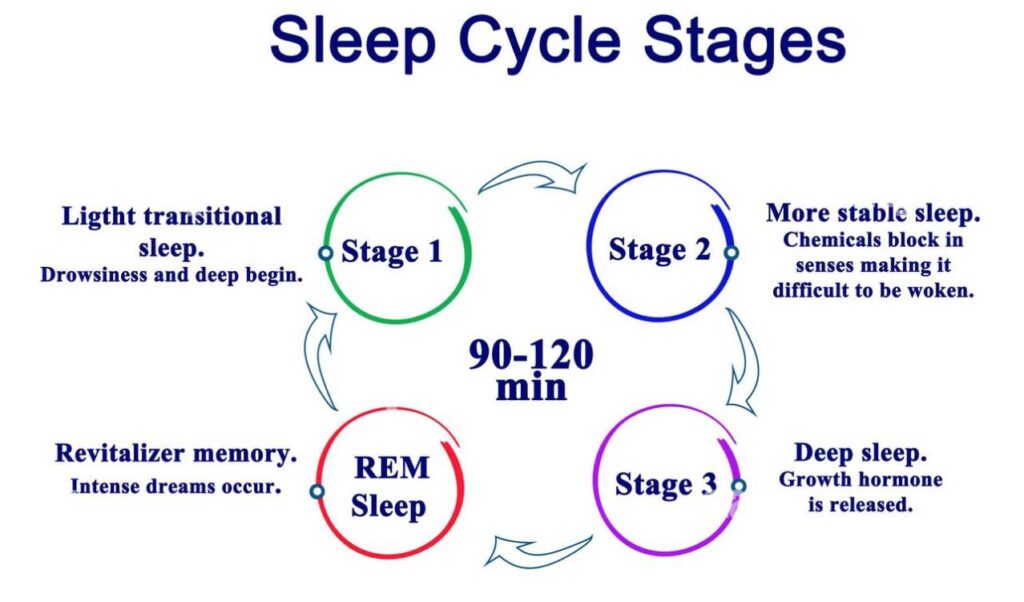
The alarm goes off and you hit the snooze button, again and again. Finally, you drag yourself out of bed and get ready for the office. But you still feel tired and sluggish. All you want to do is climb back under those comfy sheets and sleep for a few more hours. I’ve been there and done that.
We all have so much going on in our lives that it can be tempting to sacrifice sleep in order to fit everything in. However, getting enough good-quality sleep is essential for your physical, mental, and emotional health – and it can actually make you more productive and efficient at work, too.
When you sleep, your body goes through different stages of sleep. Each stage has its own unique characteristics and benefits.
Stages of Sleep
There are 3 stages of non-REM sleep, which is the deep, restful sleep that you need to feel rested and refreshed. And then there’s REM sleep, which is when you do most of your dreaming.
Understanding your sleep cycle can help you figure out why you’re not feeling rested, even if you’re getting enough hours of sleep. Maybe you’re not spending enough time in the deeper stages of non-REM sleep, or maybe you’re not getting enough REM sleep.
By learning more about your sleep cycle, you can make changes to your sleep habits and improve the quality of your rest.
So, let’s dive in and explore the different stages of non-REM sleep and REM sleep, and see how you can use this knowledge to get the restful, rejuvenating sleep that you deserve!

A sleep cycle is a series of stages that our body goes through while we are sleeping.
One sleep cycle usually lasts between 90 to 120 minutes. Each sleep cycle consists of:
- 3 stages of non-REM sleep (N1, N2, N3) followed by
- 1 period of REM sleep
During each of these stages, different physiological processes occur. This includes changes in brain activity, heart rate, and breathing.
The stages of sleep include:

1. Stage N1: Lightest Sleep
This is the lightest stage of sleep and typically lasts for a few minutes. During this stage, the body is preparing to enter deeper sleep, and the brain produces theta waves.
During the N1 stage of sleep, we experience light sleep and are easily awakened. This stage typically lasts for only a few minutes and accounts for around 5% of our total sleep time.
In this stage, our brain produces theta waves, which are slower in frequency than the alpha waves produced during wakefulness. Our muscles begin to relax, and our heart rate slows down. It’s common to experience brief muscle twitches or sudden jerks during this stage of sleep.
Interestingly, research has shown that the N1 stage of sleep may play a role in creative thinking and problem-solving. In the N1 stage, the brain is in a state of relaxed awareness, which can facilitate creative thinking and mental flexibility.
However, too much time spent in the N1 stage of sleep can lead to poor sleep quality and daytime sleepiness.
Research suggests that the N1 stage of sleep may represent a transitional stage between wakefulness and deeper sleep, which allows the brain to rest and recharge without becoming too deeply asleep (1).
2. Stage N2: Sleep Spindles
This is the stage of sleep where the body begins to relax further, and brain activity slows down. The brain produces sleep spindles and K-complexes during this stage.
The N2 stage of sleep is characterized by more pronounced muscle relaxation and a further decrease in heart rate and body temperature.
During this stage, the brain produces bursts of rapid brain wave activity known as sleep spindles and K-complexes. Sleep spindles are associated with memory consolidation, while K-complexes are thought to help the brain filter out irrelevant information.
The N2 stage of sleep is the longest stage of the sleep cycle and typically accounts for around 50% of our total sleep time. In the N2 stage, we become less responsive to external stimuli, which helps us stay asleep through minor disturbances such as background noise or movement.
However, we can still be easily awakened during this stage, especially by sudden loud noises or physical discomfort.
Sleep spindles, which occur during the N2 stage of sleep, are associated with improved memory consolidation. Sleep spindles may play a critical role in consolidating new memories and integrating them with existing knowledge.
Researchers have noted that those with higher sleep spindle activity during the N2 stage of sleep perform better on memory tasks the following day than those with lower sleep spindle activity. (2).
3. Stage N3: Slow-Wave Sleep
This is the deepest stage of non-REM sleep, also known as slow-wave sleep. During this stage, the body is in a state of rest and repair, and brain activity slows down even further.
The N3 stage of sleep, also known as slow-wave sleep, is the deepest stage of non-REM sleep. In the N3 stage, our breathing and heart rate slow down even further, and our muscles are fully relaxed. The brain produces very slow delta waves, which are associated with the deepest levels of relaxation and restoration.
During the N3 stage of sleep, the body is in a state of rest and repair. This is when the body produces the majority of its growth hormone, which is important for physical development and repair.
The N3 stage of sleep is also important for immune function, as it allows the body to repair and regenerate tissues and fight off infections. However, as we age, we tend to spend less time in the N3 stage of sleep, which can contribute to age-related health problems.
A study published in the journal Sleep Medicine found that individuals who spent more time in the N3 stage of sleep had better immune function than those who spent less time in this stage (3).
The researchers suggested that the deep relaxation and restoration that occurs during the N3 stage of sleep allows the body to repair and regenerate tissues, which is critical for maintaining a healthy immune system.
4. Stage 4: REM Sleep
Rapid eye movement (REM) sleep is the stage of sleep where we dream. During this stage, the brain becomes more active, and the body experiences muscle paralysis to prevent us from acting out our dreams.
The REM stage of sleep is characterized by rapid eye movements and increased brain activity. During this stage, the brain becomes more active, and the body experiences muscle paralysis to prevent us from acting out our dreams.
REM sleep typically accounts for around 20-25% of our total sleep time and occurs in cycles throughout the night.
REM sleep is important for cognitive function and memory consolidation. Research has shown that REM sleep helps us consolidate new memories and strengthen existing ones. It’s also important for emotional regulation and mood regulation, as it allows us to process and cope with emotional experiences.
However, too much or too little REM sleep can have negative effects on our mental health and cognitive function.
Researchers suggest that REM sleep allows the brain to process and cope with emotional experiences, which may be essential for maintaining good mental health.
Those who are deprived of REM sleep for several nights experience more negative emotions and are less able to regulate their emotional responses than those who received normal amounts of REM sleep (4).
Conclusion

Each sleep cycle is important for different aspects of our health and well-being.
For example, deep sleep is important for physical restoration and immune function, while REM sleep is important for cognitive function, memory consolidation, and emotional regulation.
Understanding our personal sleep cycle can help us improve the quality of our sleep and wake up feeling more rested and refreshed.
Read more: How to Improve Your Sleep Quality: 25 Best Tips for Falling Asleep Faster
